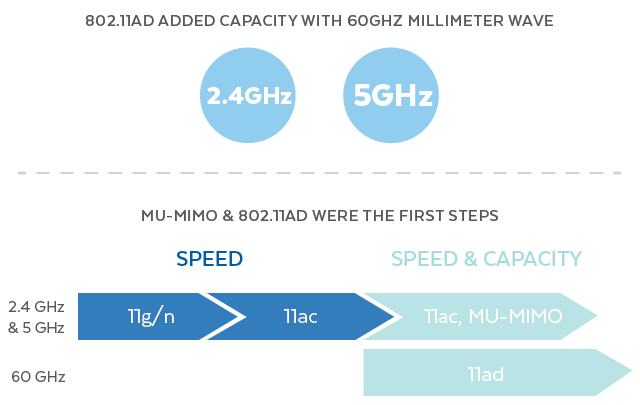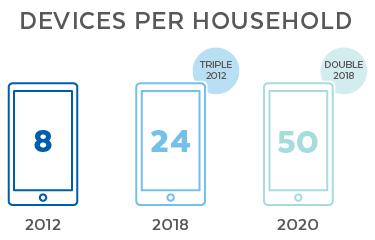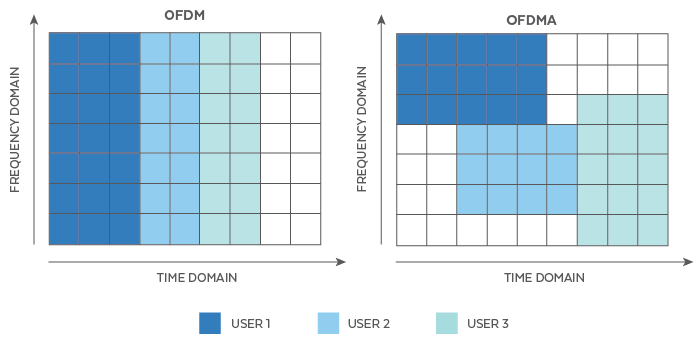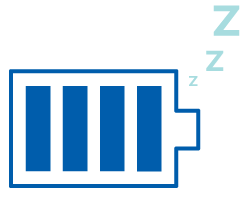Ever go out to the mall or public place for a few hours and when you return, you find your mobile phone battery has literally drained dry—without ever having used it? I have. Why does something like this happen when it literally sat in your pocket the whole time? What is that silent battery killer? Sadly, more often than not, it’s the WiFi. Thankfully, that’s all about to change thanks to the IEEE 802.11ax standard.
Faster, expanded WiFi coverage is coming to a wireless access point near you, thanks to something called OFDMA. That’s GOOD for businesses, for end users, for you and the people you do installations for.
Back in 2012, the average household boasted 8 devices. Today, we’re at 3 times that. In 2022, it’ll be twice that again at 50 devices. How does a home network, much less a public space like a college campus, shopping mall, or public transportation like a commuter train, keep up?
This article will discuss some of the features of the IEEE 802.11ax in this newest generation of WiFi.
Improve Wifi Network Capacity With 802.11ax
Nobody hangs around a WiFi dead zone. High device-density can make it hard to get onto a wireless network. Device density is only going to thicken as numbers of connected things continue to increase. An estimated 8.4 billion devices are connected to the Internet right now. That’s higher than the world’s population.
Gartner, the think-tank and research house, estimates that number may reach an astounding 20.4 billion by 2020.
So, what is IEEE 802.11ax and how is it going to help people who want WiFi?
This new WiFi standard offers 3 main technological improvements:
- Expanded capacity
- Higher speeds
- Less battery drain
Not too shabby. In fact, it’s hard to imagine anything else that might be needed. Let’s dig down and take a closer look at how these things work.
1. Expanded network capacity
OFDMA technology allows multiple end users to “ride” the same frequency wave at the same time without interference. Here’s what the letters stand for:
- Orthogonal
- Frequency division
- Multiple access
Orthogonality means that sub-carrier frequencies are chosen so that their spacing eliminates cross-talk or interference between subchannels. That eliminates the need for intercarrier guard bands, freeing up more space.
If you’ve ever shuffled a deck of cards or seen someone else do it, data is transmitted in a similar way. One packet slides in between another like the cards. Each stream of data is kept distinct but it flows into the channel in sub-channels.
That is how multiplexing works. Signals that are multiplexed to travel across the network.
If you could take a laser and do cut across that stream, this image gives you an idea of how efficiently this frequency real estate is used:
- OFDM – Is the previous standard. Each transmission was constant stream and the next device in the queue had to wait for prior transmissions to complete before initiating into the wireless network. Essentially, you have to wait your turn.
- OFDMA – With this new technology, data transmissions are sent simultaneously up to 30 simultaneous transmissions may occur at any given time.
That makes getting onto a network much easier.
Further capacity expansion through additional antennae
Multi-user MIMO (multiple-input,multiple-output) deployments gain further capacity through the use of additional antennas. In other words, more than one stream that does what was just described.
The potential is to multiply streams 4x and even up to 8x increase in recent solutions being brought to market.
That’s just the beginning, we are moving toward the day when up to 100x may be the norm.
Further capacity expansion through an added frequency band
With 802.11ad, an additional frequency range has also being added. Most people are familiar with the 2.4 GHz and 5 GHz bands. It won’t be too long until we see 60 GHz moving onto the scene.

2. Higher speeds
Some of you might have read the breathless admiration of AX WiFi routers from CES 2018. There is every reason for excitement over speeds topping out at 6 Gbps. That’s 300 times the average Internet speed.
At 6Gbps a lot of people can stream video and audio at the mall or on a commuter train, and not disrupt the ability of others to check email or do a search.
Though AX isn’t yet “official” the day it goes live (2019 is the general target) it is definitely going to be a huge step forward.
Higher throughput
And with the new AX standard, data packets are actually larger. That means it takes less time for the same amount of data to transmit: 64-QAM allows more data to be transmitted on the same bandwidth.
What that means is that 802.11ax has a higher capacity throughput, the amount of data your network can move in one transmission.
So far, expanded capacity and faster speeds are showing that it’ll be easier to get WiFi and that the quality of the WiFi will be much better. But, what about that dead battery?
3. Less drain on your battery
One problem in the earlier WiFi versions that depleted cell phone batteries was the signal search mechanism. Even if YOU weren’t trying to get onto a WAN, your phone would consume power searching.
Just walking into a WiFi coverage area could trigger this function.
Working Teams for IEEE 802.11ax-2019 were tasked with making sure the 802.11ax standard did not consume more power than the previous amendments.
The AX also standard transmits more data in a single packet and requires low-power hardware functionalities and low-power PHY / MAC functionalities.
In plain language, the solution for battery drain is sleep mode functionality, also known as “wake time scheduling.” The signal tells the device to sleep in micro bursts. These tiny suspended animation intervals can save an enormous amount of battery life over the course of a session on the WAN.
One of the biggest benefits is you’ll be able to call someone when you leave the mall or the commuter train, without having to find a free recharging station.
Final Thoughts
The 802.11ax is a next-generation solution intended to remedy dense WLAN scenarios so that overlapping channels, many stations (STA) under the coverage of a single AP would not collide.
Interference issues, packet rate error and reduction of concurrent transmission in neighboring areas would not prevent people from accessing coverage—was the whole point. Multiple antennas, low-power hardware architecture and orthogonal multiplexing are definitely pulling this exciting upgrade across the finish line.
Simple yet brilliant advancements are leveraging these capabilities.
- Expanded capacity through use of subcarrier waves and additional streams
- Speeding up things up to 4x faster through 160 MHz channels
- Using micro-sleep mode to preserve battery life
If you need help designing a WLAN or choosing the right components for your installation, you can request a custom quote from our team of analysts.




Join the Discussion One Comment